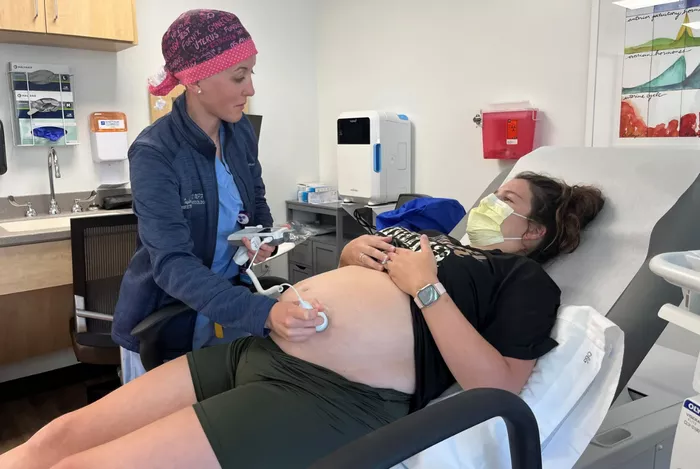OSKALOOSA, Iowa — The rural areas around this southern Iowa town once had more babies and more places to give birth to them.
Since 2000, at least 41 Iowa hospitals have closed their labor and delivery units. These hospitals, about a third of all in Iowa, are mostly in rural areas where birth numbers have dropped significantly. In some counties, annual births have fallen by three-quarters since the 1950s and ’60s baby boom when many rural hospitals were built or expanded.
This trend is seen nationwide as hospitals struggle to maintain staff and facilities for the few births they handle. Over half of rural U.S. hospitals no longer offer maternity services.
“People just aren’t having as many kids,” said Addie Comegys, who travels 45 minutes each way for prenatal checkups at Oskaloosa’s hospital. Her mother had six children in the 1980s, but now, having three kids seems a lot.
Today, many Americans choose smaller families or no children. Modern birth control aids these decisions. In small towns, this trend is worsened when young adults move away, taking their potential to have children with them.
Hospital leaders who close obstetrics units often cite declining birth numbers, staffing challenges, and financial losses. These closures can be particularly tough for pregnant women who lack reliable transportation and flexible schedules to travel for care.
The baby boom peaked in 1957 with about 4.3 million births in the U.S. By 2022, births dropped below 3.7 million, even as the U.S. population nearly doubled.
West Virginia has seen the biggest decline in births, a 62% drop over 65 years. Iowa’s births dropped 43% in the same period. Only four of Iowa’s 99 counties, all urban or suburban, recorded more births.
Births have increased in only 13 states since 1957. States like Arizona, California, Florida, and Nevada have seen increases due to waves of newcomers. However, even these states have had rural obstetrics units close.
Oskaloosa’s hospital has managed to keep its labor and delivery unit open by attracting patients from 14 other counties. Last year, it recruited two obstetrician-gynecologists to expand services.
Mahaska Health, Oskaloosa’s hospital, expects to deliver 250 babies this year, up from about 160 in previous years, said CEO Kevin DeRonde. “It’s an essential service, and we needed to keep it going and grow it,” he said.
Many U.S. hospitals dropping obstetrics units were built or expanded in the mid-1900s with federal funding from the Hill-Burton Act. “It was an amazing program,” said Brock Slabach, chief operations officer for the National Rural Health Association. “Basically, if you were a county that wanted a hospital, they gave you the money.”
Slabach noted that declining birth numbers and shorter hospital stays after births reduce occupancy in obstetrics units. In the past, patients spent several days in the hospital after giving birth, but now they often go home after a night or two.
Low caseloads can raise safety concerns. A 2023 JAMA study found women were more likely to suffer serious complications if they gave birth in rural hospitals handling 110 or fewer births a year. The authors recommended improving training and coordination among rural health providers rather than closing low-volume units.
Stephanie Radke, an obstetrics and gynecology professor at the University of Iowa, said it’s almost inevitable that rural obstetrics units will close as birth numbers drop. “We talk about that as a bad event, but we don’t really talk about why it happens,” she said. She emphasized that maintaining quality care for pregnant women and their babies is more important than keeping a set number of obstetrics units open.
Radke noted that some hospitals have consolidated obstetrics units, pooling resources to maintain sufficient staff and case numbers. “You’re not always really creating a care desert when that happens,” she said.
The decline in births has accelerated in recent years. Kenneth Johnson, a sociology professor at the University of New Hampshire, said it’s understandable that many rural hospitals have closed obstetrics units. “I’m actually surprised some of them have lasted as long as they have,” he said.
Johnson added that rural areas with the steepest population declines tend to be far from cities and lack recreational attractions. Some areas have avoided population losses by attracting immigrant workers, who often have larger families in the first generation or two after moving to the U.S.
Katy Kozhimannil, a health policy professor at the University of Minnesota, said declining birth numbers and obstetrics unit closures can create a vicious cycle. Fewer births can lead to unit closures, which can discourage young people from moving to the area, driving birth numbers even lower.
In many regions, people with private insurance, flexible schedules, and reliable transportation travel to larger hospitals for prenatal care and to give birth. This leaves rural hospitals with a larger proportion of Medicaid patients, a public program that pays about half what private insurance pays for the same services.
Iowa ranks near the bottom of states for obstetrician-gynecologists per capita. But Oskaloosa’s hospital recruited Taylar Swartz and Garth Summers, a married couple who recently finished their obstetrics training. Swartz grew up in the area and wanted to serve women there.
She hopes the number of obstetrics units will stabilize after the wave of closures. “It’s not even just for delivery, but we need access just to women’s health care in general,” she said. Swartz plans to help spark interest in rural obstetrics by hosting University of Iowa residency rotations at Oskaloosa’s hospital.
Comegys, a patient of Swartz, chose Oskaloosa’s hospital for its quality despite the distance. She has a flexible job, a reliable car, and supportive family, enabling her to travel for care. She knows many women are not so lucky and worries that other obstetrics units are at risk.
“It’s sad, but I could see more closing,” she said.


